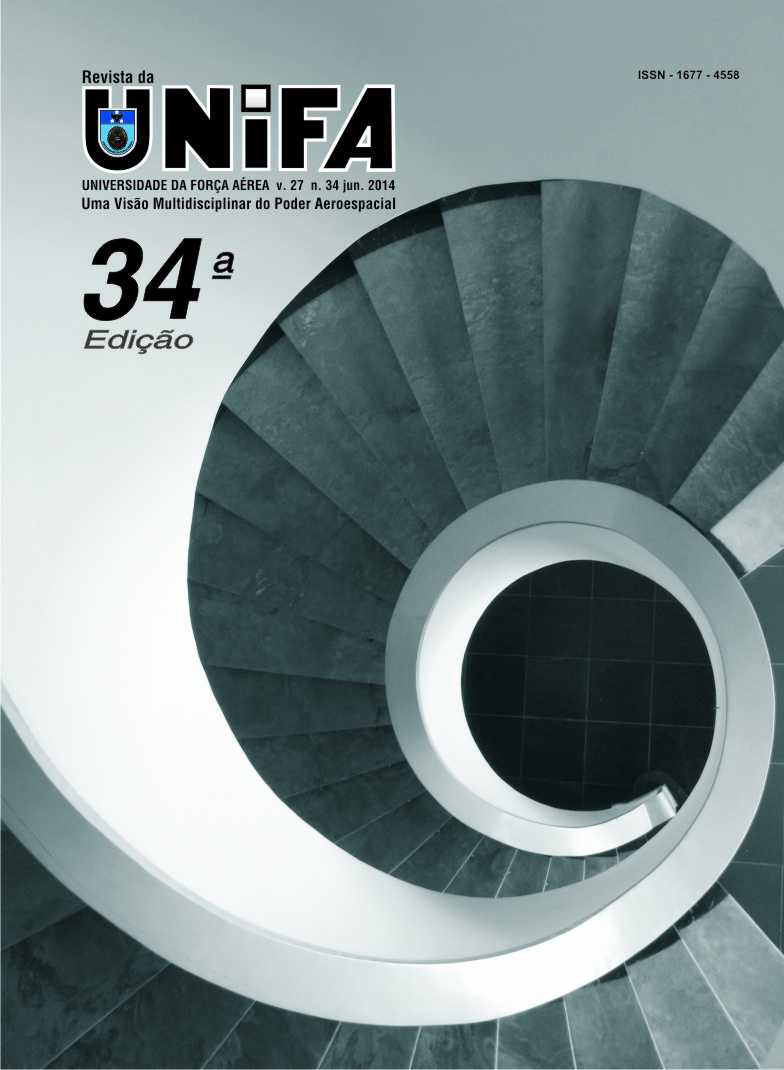The correlation between anthropometric variables and body fat percentage in military young adults at the Brazilian Air Force
DOI:
https://doi.org/10.22480/revunifa.2014.27.566Keywords:
Percentage of fat, Anthropometry, Body mass index, Waist circumferenceAbstract
This work aims to investigate to what extent the variables related to weight, height and waist circumference
(WC) of the Brazilian Air Force Command Militaries (COMAER) between 20 and 30 years old, assessed by the
Physical Fitness Assessment Test (PFAT) in 2012, correlate with body fat percentage (%BF). The research group
consisted of 986 men and 196 women from 10 different Military Organizations from the COMAER. The body
mass index (BMI), the waist circumference, the waist-to-height ratio (CER), and the waist product - BMI (WPBMI)
were the independent variables and the %BF estimated by skinfold, was the dependent variable. The highest
values for men, found for the Pearson correlation coefficient (r), were 0.709, when combined with WPBMI, and
0.624 for women, when associated with BMI. The regressions of %BF had coefficients of determination (R2
) of 59.6% for CC and 64.2% for WPBMI, when taking into account gender and age. In conclusion, the correlations
must be used with caution in determining %BF. Nevertheless, this research revealed that the WPBMI, because
it is an index linked to the amount and distribution of body fat, has the potential to be a new indicator in the
clinical evaluation of body composition. It is suggested the execution of new research to clinical validation of
WPBMI, and the adoption of other sites for the determination of %BF using anthropometric variables.
References
AMERICAN COLLEGE OF SPORTS MEDICINE. Teste de esforço e prescrição de exercício. 6 ed. Rio de Janeiro: Revinter, 2003.
BRASIL. Comando da Aeronáutica. Departamento de Ensino. ICA 54-1: teste de avaliação do condicionamento físico no Comando da
Aeronáutica. Rio de Janeiro, 2011.
DEURENBERG, Paul; DEURENBERG-YAP, Mabel; VAN STAVEREN, W. A. Body mass index and percent body fat: a meta analysis among different ethnic groups. International Journal of Obesity, v. 22, n. 12, p. 1164, 1998.
DEURENBERG, Paul; WESTSTRATE, J. A.; SEIDELL, J. C. Body mass index as a measure of body fatness: age- and sex-specific prediction formulas. British Journal of Nutrition, v. 65, n. 2, p. 105-114, mar. 1991.
DUMITH, Samuel C. et al. Associação entre gordura corporal relativa e índice de massa corporal, circunferência da cintura, razão cintura-quadril e razão cintura-estatura em adultos jovens. Revista Brasileira de Atividade Física e Saúde, Londrina, v. 14, n. 3, p. 174-181, out. 2009.
UNITED STATES AIR FORCE. Air Force Instruction 36-2905. Disponível em:< http://static.e-publishing.af.mil/production/1/af_a1/publication/afi36-2905/afi36-2905.pdf.>. Acesso em: 22 jun. 2013.
FLEGAL, Katherine. M. et al. Comparisons of percentage body fat, body mass index, waist circumference, and waist-stature ratio in adults. American Journal of Clinical Nutrition, v. 89, p. 500-508, 2009.
HEINRICH, Kotre M. et al. Obesity classification in military personnel: a comparison of body fat, waist circumference, and body mass index measurements. Military Medicine, v. 173, n. 1, p. 67-73, jan. 2008.
HEYWARD, V. H.; STOLARCZYK, L. M. Avaliação da composição corporal. São Paulo: Manole, 2000.
JACKSON, A. S.; POLLOCK, M.L. Generalized equation for predicting body density for men. British Journal of Nutrition, Cambridge, n. 4, p. 497-504, 1978.
JACKSON, A. S.; POLLOCK, M. L.; e WARD, A. Generalized equations for predicting body density of women. Medicine and Science in Sports and Exercise, v. 12, n. 3, p. 175-182, 1980.
JANSSEN, Ian et al. Body mass index and waist circumference independently contribute to the prediction of nonabdominal, abdominal subcutaneous, and visceral fat. The American Journal of Clinical Nutrition, v. 75, p. 684-688, 2002.
JANSSEN, Ian; KATZMARZYK, Peter T.; ROSS, R. Waist circumference and not body mass index explains obesity-related health risk. The
American Journal of Clinical Nutrition, v. 79, p. 379-384, 2004.
LOHMAN et al. Methodological factors and preditions of body fat in female athletes. Medicine and Science in Sports and Exercise, v. 16, n. 1, p. 92-96, 1984.
LOPES JÚNIOR, M. X. A coleta de dados antropométricos no Teste de Avaliação do Condicionamento Físico do COMAER. 2013.
Monografia. (Curso de Comando e Estado Maior, 2013). Escola de Comando e Estado Maior da Aeronáutica, Universidade da Força Aérea, Rio de Janeiro, 2013.
POLLOCK, M. J. et al. Analyses of measurement error related to skinfold site, quantity of skinfold fat, and sex. Medicine and Science in Sports and Exercise. v. 18, p. 32, 1986.
POLLOCK, M. L.; WILMORE, J. H. Exercícios na saúde e na doença: avaliação e prescrição para prevenção e reabilitação. 2. ed. Rio de Janeiro: MEDSI, 1993.
SIRI, W.E. Body composition from fluid spaces and density. In: BROZEK, J.; HENSCHEL, A. Techniques for measuring body composition.
Washington, D.C.: National Academy of Science. p. 223-224, 1961.
STEWART, A. et al. International standards for anthropometric assessment. 2. ed. New Zealand: ISAK, 2011.
WEI, M. et al. Waist circumference as the best predictor of noninsulin dependent diabetes mellitus (NIDDM) compared to body mass
index, waist/hip ratio and other anthropometric measurements in Mexican Americans: a 7 year prospective study. Obesity Research, v. 5, n. 1, p. 16-23 jan. 1996
Downloads
Published
Issue
Section
License
Copyright (c) 2014 Pedro Celso Gagliardi Palermo

This work is licensed under a Creative Commons Attribution-NonCommercial 4.0 International License.
Revista da UNIFA permite que o (s) autor (es) mantenha(m) seus direitos autorais sem restrições. Atribuição-NãoComercial 4.0 Internacional (CC BY-NC 4.0) - Revista da UNIFA é regida pela licença CC-BY-NC









